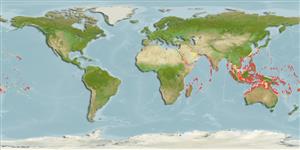Common names from other countries
>
Eupercaria/misc (Various families in series Eupercaria) >
Scaridae (Parrotfishes) > Scarinae
Etymology: Bolbometopon: Greek, bolbos-ou = onion + Greek, metopon = brow (Ref. 45335).
More on author: Valenciennes.
Environment: milieu / climate zone / depth range / distribution range
นิเวศวิทยา
เกี่ยวกับทะเล,น้ำเค็ม เกี่ยวกับหินโสโครก; ระดับความลึก 0 - 40 m (Ref. 90102). Tropical; 34°N - 26°S, 32°E - 145°W (Ref. 116632)
Indo-Pacific: Red Sea and East Africa to Samoa and the Line Islands, north to the Yaeyama and Wake islands, south to the Great Barrier Reef and New Caledonia.
ขนาด / น้ำหนัก / Age
Maturity: Lm ? range ? - ? cm
Max length : 130 cm TL เพศผู้/กระเทย; (Ref. 9710); common length : 70.0 cm SL เพศผู้/กระเทย; (Ref. 9793); น้ำหนักสูงสุดที่มีการรายงาน: 46.0 kg (Ref. 2334)
Short description
เครื่องมือที่ใช้ในการแยกชนิดสัตว์,สิ่งมีชีวิตออกจากกัน | สัณฐานวิทยา | ความยาวต่างๆ
เงี่ยงครีบหลัง (รวม) : 9; ก้านครีบอ่อนที่หาง (รวม) : 10; เงี่ยงครีบก้น: 3; ก้านครีบอ่อนที่ก้น: 9. This species is distinguished by the following characters: median predorsal scales 2-4 (may be obscured by hump); 3 scale rows on cheek, 1 (4-6), 2 (3-6), 3 (1-2); pectoral-fin rays 16 or 17; steep profile distinctive; nodules on teeth unique (Ref. 9793); prominent bump on forehead of adult (evident at least 25 cm TL); deep body 2.0-2.5 in SL, with depth increasing with growth; Colour of juveniles brownish to green with 5 vertical rows of whitish spots on side, the primary phase is a dull gray with scattered white spots, gradually becoming uniformly dark green (Ref. 90102, 1602).
Juveniles are found in lagoons while adults inhabit clear outer lagoon and seaward reefs up to depths of at least 30 m (Ref. 9710). They ‘sleep’ in caves and often in shipwrecks at night (Ref. 48636). They are usually in small groups feeding on benthic algae, live corals (Ref. 9710) and shellfishes (Ref. 58784). They sometimes ram their head against corals to facilitate feeding (Ref. 9710). The largest and wariest of the parrotfishes. Assessments showed their vulnerability to overfishing (Ref. 9710). Minimum depth reported taken from Ref. 128797.
Life cycle and mating behavior
Maturities | การสืบพันธุ์ | Spawnings | Egg(s) | Fecundities | ตัวอ่อน
Oviparous, distinct pairing during breeding (Ref. 205). Also Ref. 103751.
Randall, J.E., G.R. Allen and R.C. Steene, 1990. Fishes of the Great Barrier Reef and Coral Sea. University of Hawaii Press, Honolulu, Hawaii. 506 p. (Ref. 2334)
IUCN Red List Status (Ref. 130435)
CITES (Ref. 128078)
Not Evaluated
Threat to humans
Harmless
Human uses
การประมง: การค้า; สถานที่แสดงสัตว์และพืชน้ำ: การค้า
เครื่องมือ
Special reports
Download XML
แหล่งที่มาจากอินเตอร์เน็ต
Estimates based on models
Preferred temperature (Ref.
115969): 25.3 - 29.1, mean 28.2 (based on 2570 cells).
Phylogenetic diversity index (Ref.
82804): PD
50 = 1.0000 [Uniqueness, from 0.5 = low to 2.0 = high].
Bayesian length-weight: a=0.01380 (0.00641 - 0.02973), b=3.03 (2.86 - 3.20), in cm Total Length, based on LWR estimates for this (Sub)family-body shape (Ref.
93245).
ระดับชั้นอาหาร (Ref.
69278): 2.7 ±0.41 se; based on food items.
ความสามารถในการกลับคืนสู่ปกติ (Ref.
120179): ต่ำ, เวลาต่ำสุดที่จะทำให้ประชากรเพิ่มขึ้นเป็น 2 เท่าใช้เวลา 4.5 - 14 ปี (K=0.10).
Fishing Vulnerability (Ref.
59153): High to very high vulnerability (67 of 100).
Climate Vulnerability (Ref.
125649): Very high vulnerability (92 of 100).
